
Bulletin 28, 1976
Home
Français
Introduction
History
Annual Index
Author &
Subject
Credits
Contact
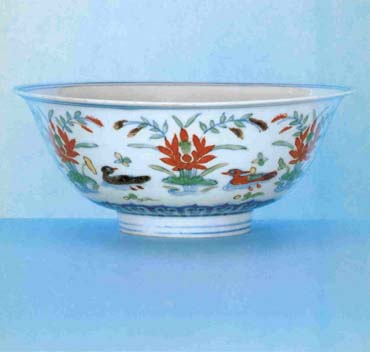
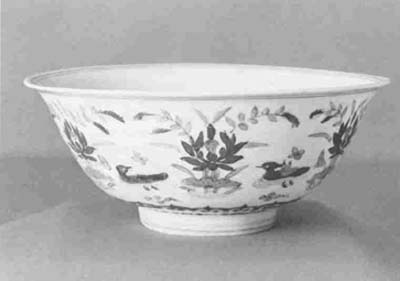
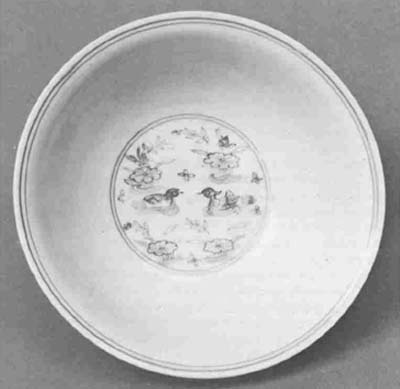

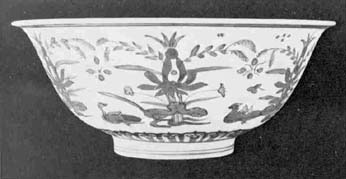
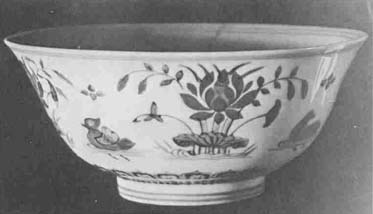
Mandarin
Ducks in Sixteenth-Century Chinese Porcelain: A Wan-li Bowl in the
National Gallery of Canada
by Yutaka Mino and Katherine Tsiang
Résumé en français
Pages 1 | 2
| 3
The National Gallery of
Canada recently had the good fortune to receive a gift of a
porcelain bowl of the Ming dynasty (1368-1644) from an anonymous
donor. Though the only example of Chinese porcelain in this
collection, it is a highly valuable and unusual piece worthy of
special attention (figs 1-3). It is all the more remarkable that the
Gallery, in spite of its inability to devote its resources to the
expansion of its small Chinese collection, should have come into
possession of such a rare object.
The bowl has an everted mouth rim and a straight vertical foot. Both
the inside and outside are decorated with scenes of mandarin ducks
in a pond, surrounded by lotuses and other aquatic plants. The
painting is executed in red, yellow, green, and brown enamels over
underglaze blue outlines. In one area, the row of lotus-petal panels
around the foot, the decoration is painted in underglaze blue only.
The six-character reign-mark Ta Ming Wan-Ii nien tsao ("Made
in the W an-li period of the great Ming dynasty") is written in
blue on the underside of the bowl (fig. 3). Double blue lines
encircle the inscriptions, the outside of the foot, the painted area
inside the bowl, and the inside and outside surfaces of the mouth
rim. The piece is of exceptionally high quality and, aside from a
small chip in the rim, is in good condition. Evidence of some wear
can be seen on the inside of the bowl where the overglaze enamels
have been rubbed off to an extent; however the blue outlines,
protected by the hard porcelain glaze, are unharmed.
The blue lines are drawn under the glaze in cobalt oxide. The
enamels, which are coloured by various other metallic oxides and
"fritted" with lead, are applied over the glaze after the
piece is fired to porcelain hardness, mainly filling the areas
bounded by blue. This technique is known in Chinese as tou-ts'ai
(often translated as contending or contrasting colours). A piece
such as this would have undergone a number of successive firings
before reaching its finished state. After the first, biscuit firing,
the blue lines were painted on the body, followed by the application
of a transparent glaze and a second firing at temperatures in the
range of 1280 to 1350 degrees centigrade. Several firings at
progressively lower temperatures were usually required for the
various colours of enamel glazes which produced their optimum
colours and fused at different degrees of heat.
The tou-ts'ai technique was first used and perfected
in the Ch'eng-hua period (1465-1487). It was used on small objects
as its light decorativeness is best suited to the most delicate
wares such as wine cups. The products of this period were so
admired and treasured that they were often imitated in later times.
Only three other bowls like the one in Ottawa are known to exist:
one in the National Palace Museum, Taipei (1) (figs 4-6); one in the
Palace Museum, Peking (2) (fig. 7); and a third recently sold in
auction at Sotheby's (3) (fig. 8). The Ottawa, Taipei, and Sotheby
bowls are nearly identical in shape, size, and decoration; and
these three bear the Wan-li reign-mark.
A few small differences distinguish each piece from the others, as
though they had been painted by different hands. Around the foot
of the Ottawa bowl there are two small dots of blue in each
lotus-petal panel, while on the Taipei and Sotheby pieces these
spots are left unfilled. The Sotheby piece is perhaps most similar
to the one in Ottawa. Above each lotus Rower on the Sotheby
example is a round, green spot rather like the flaming jewel of
Buddhist iconography. This spot, which on the Ottawa bowl is shown
as being on top of the seed pod of the Rower, has become detached
and floats above the flower, while the petal behind the seed pod has
been interpreted as a red flame rising from the jewel-like spot. On
the Taipei bowl, the central seed pod is reduced to a simple green
dot but remains suspended in the centre of the Rower: the petal
behind it is transformed into a round fruitlike formation with
leaves springing from the top. The duckweed between the lotuses on
the Taipei piece are unlike those on the others - the leaves drifting
on long stems instead of joining together directly in the centre.
On the Peking piece the lotuses are larger in proportion to the
height of the sides. The centre of the Rowers is shown as a green
dot and the area around it filled in with yellow. The blue
lotus-petal panels have an additional outline around them. This bowl
appears to be shallower and the mouth less widely everted than the
other examples. It has been attributed to the Ch' eng-hua period;
however its very close resemblance to the other three bowls
bearing the Wan-li reign-mark make a Ch' eng-hua date highly
unlikely. (4)
The motif of mandarin ducks on a lotus pond is not known on tou-ts'ai
ware of the Ch'eng-hua period, although it appears in porcelain
decoration both before and after this period. Mandarin ducks are
the Chinese symbol of marital fidelity as they were observed to
mate and remain with a single partner for life. They were depicted
on Chinese porcelain during the Yüan dynasty (1271-1368).
Confronting pairs of ducks, and pairs of ducks swimming in the
same direction with one turning back to look at the other, appear
on fourteenth-century blue-and-white bowls, basins, vases, and
plates (fig. 9). (5) The motif re-emerges in the middle of the Ming
dynasty and can be seen on a tsun vase of the late
fifteenth-century. (6)
The ducks on the body of this tsun vase alternate
with clumps of lotuses. The waves beneath the lotuses are rendered
as overlapping groups of concentric rings with streams of spray
leaping up from them. This formula for waves is also used on a
small blue-and-white jar with a Ch' eng-hua reign-mark on the base.
(7) However the lotuses on this jar are not grouped but
distributed evenly around it. Lotuses and aquatic grasses arranged
in clumps in very much the same form as they appear on the Wan-li
bowls had come into use in porcelain decoration by the beginning of
the sixteenth-century, as evidenced by a blue-and-white bowl bearing
a reign-mark of the Cheng-te period (1506-1521). (8) The grouping on
the bowl also includes a central lotus flower above a large leaf,
with small leaves and shoots surrounding it and ripples of water
beneath it.
Next Page | The
theme of ducks
1 | 2
| 3
Annual Index | Author & Subject | Credits | Contact
This digital collection
was produced under contract to Canada's Digital Collections program,
Industry Canada.
"Digital
Collections Program, Copyright
© National Gallery of
Canada 2001"